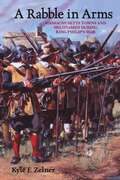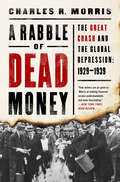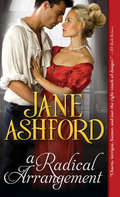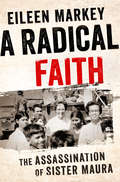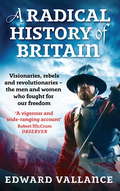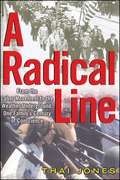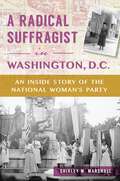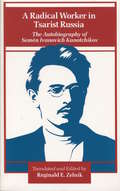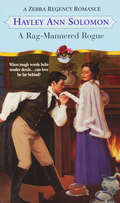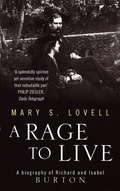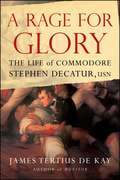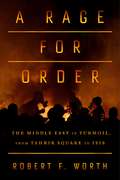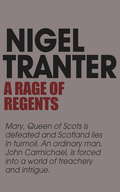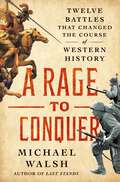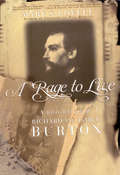- Table View
- List View
A Rabble in Arms: Massachusetts Towns and Militiamen during King Philip’s War (Warfare and Culture #5)
by Kyle F. ZelnerWhile it lasted only sixteen months, King Philip’s War (1675-1676) was arguably one of the most significant of the colonial wars that wracked early America. As the first major military crisis to directly strike one of the Empire’s most important possessions: the Massachusetts Bay Colony, King Philip’s War marked the first time that Massachusetts had to mobilize mass numbers of ordinary, local men to fight. In this exhaustive social history and community study of Essex County, Massachusetts’s militia, Kyle F. Zelner boldly challenges traditional interpretations of who was called to serve during this period.Drawing on muster and pay lists as well as countless historical records, Zelner demonstrates that Essex County’s more upstanding citizens were often spared from impressments, while the “rabble” — criminals, drunkards, the poor— were forced to join active fighting units, with town militia committees selecting soldiers who would be least missed should they die in action. Enhanced by illustrations and maps, A Rabble in Arms shows that, despite heroic illusions of a universal military obligation, town fathers, to damaging effects, often placed local and personal interests above colonial military concerns.
A Rabble of Dead Money: 19291939
by Charles R. MorrisThe Great Crash of 1929 profoundly disrupted the United States' confident march toward becoming the world's superpower. The breakneck growth of 1920s America--with its boom in automobiles, electricity, credit lines, radio, and movies--certainly presaged a serious recession by the decade's end, but not a depression. The totality of the collapse shocked the nation, and its duration scarred generations to come.In this lucid and fast-paced account of the cataclysm, award-winning writer Charles R. Morris pulls together the intricate threads of policy, ideology, international hatreds, and sheer individual cantankerousness that finally pushed the world economy over the brink and into a depression. While Morris anchors his narrative in the United States, he also fully investigates the poisonous political atmosphere of postwar Europe to reveal how treacherous the environment of the global economy was. It took heroic financial mismanagement, a glut-induced global collapse in agricultural prices, and a self-inflicted crash in world trade to cause the Great Depression.Deeply researched and vividly told, A Rabble of Dead Money anatomizes history's greatest economic catastrophe--while noting the uncanny echoes for the present.
A Race Is a Nice Thing to Have: A Guide to Being a White Person or Understanding the White Persons in Your Life
by Janet E. HelmsFor racism to disappear in the United States, White people must take the responsibility for ending it. For them to assume that responsibility, they must become aware of how racism hurts White people and consequently, how ending it serves White people's best interests. Moreover, this awareness not only must be accompanied by enhanced abilities to recognize the many faces of racism, but also by the discovery of options to replace it.
A Race for the Future: Scientific Visions of Modern Russian Jewishness
by Marina MogilnerThe forgotten story of a surprising anti-imperial, nationalist project at the turn of the twentieth century: a grassroots movement of Russian Jews to racialize themselves.In the rapidly nationalizing Russian Empire of the late nineteenth century, Russian Jews grew increasingly concerned about their future. Jews spoke different languages and practiced different traditions. They had complex identities and no territorial homeland. Their inability to easily conform to new standards of nationality meant a future of inevitable assimilation or second-class minority citizenship. The solution proposed by Russian Jewish intellectuals was to ground Jewish nationhood in a structure deeper than culture or territory—biology.Marina Mogilner examines three leading Russian Jewish race scientists— Samuel Weissenberg, Alexander El’kind, and Lev Shternberg—and the movement they inspired. Through networks of race scientists and political activists, Jewish medical societies, and imperial organizations like the Society for the Protection of the Health of the Jewish Population, they aimed to produce “authentic” knowledge about the Jewish body, which would motivate an empowering sense of racially grounded identity and guide national biopolitics. Activists vigorously debated eugenic and medical practices, Jews’ status as Semites, Europeans, and moderns, and whether the Jews of the Caucasus and Central Asia were inferior. The national science, and the biopolitics it generated, became a form of anticolonial resistance, and survived into the early Soviet period, influencing population policies in the new state.Comprehensive and meticulously researched, A Race for the Future reminds us of the need to historically contextualize racial ideology and politics and makes clear that we cannot fully grasp the biopolitics of the twentieth century without accounting for the imperial breakdown in which those politics thrived.
A Race to Splendor
by Ciji WareInspired by female architect Julia Morgan, this is the riveting tale of a race against time to rebuild two luxury hotels after the 1906 San Francisco earthquake destroyed 400 city blocks and left 250,000 homeless. Morgan's fictional protegee Amelia Bradshaw and client J.D. Thayer will sacrifice anything to see the city they love rise from the ashes; in the process, they can't help but lose their hearts.
A Race to the Bottom of Crazy: Dispatches from Arizona
by Richard GrantThe bestselling author of Dispatches from Pluto and The Deepest South of All turns his sharp wit and observational powers on the epicenter of America&’s most divisive issues: Arizona.When Richard Grant and his wife moved with their four-year-old daughter back to Tucson, Arizona, where the couple first met, he expected to easily rekindle his love of the region. Instead, he found a housing market gone haywire, rampant election conspiracies, and right-wing political violence alarmingly close to his home and family. Undocumented immigration was surging, and the state was also on the front lines of climate change, breaking heat and drought records, and running out of long-term water supplies. Under these circumstances, Grant wondered how he might raise a happy, well-adjusted child who believes in the future. Yet these concerns weren&’t keeping people away: Arizona was simultaneously experiencing some of the nation&’s highest population growth. In A Race to the Bottom of Crazy, Grant mixes memoir, research, and reporting in a quest to understand what makes Arizona such a confounding and irresistible place. He visits the world&’s largest machine-gun shoot; takes a sunset boat cruise with a US Congressman and a group of far-right patriots; rides through the desert with a Border Patrol agent; and goes camping with his family in breathtaking mountain ranges that rise out of the desert like islands in the sky. Interspersed with these adventures are recollections of his previous stint in the state, including his friendship with cult writer Charles Bowden and years living off the grid with smugglers, dope farmers, and outlaws on the Mexican border. Ultimately, Grant arrives at the conclusion that Arizona has always been a scattershot improvisation, with bizarre and extreme behavior in its DNA. This book is an entertaining, illuminating, and essential guide to understanding modern America at its most overheated.
A Radical Act of Free Magic: A Novel (The Shadow Histories #2)
by H. G. Parry"A rich, sprawling epic full of history and magic, Declaration is Jonathan Strange with international politics and vampires. I loved it."―Alix E. HarrowA sweeping tale of revolution and wonder in a world not quite like our own, A Radical Act of Free Magic is the conclusion to this genre-defying series of magic, war, and the struggle for freedom in the early modern world.The Concord has been broken, and a war of magic engulfs the world.In France, the brilliant tactician Napoléon Bonaparte has risen to power, and under his command, the army of the dead has all but conquered Europe. Britain fights back, but Wilberforce&’s own battle to bring about free magic and abolition has met a dead end in the face of an increasingly repressive government. In Saint-Domingue, Fina aids Toussaint Louverture as he navigates these opposing forces to liberate the country.But there is another, even darker war being fought beneath the surface: the first vampire war in hundreds of years. The enemy blood magician who orchestrated Robespierre&’s downfall is using the French Revolutionary Wars to bring about a return to dark magic. Across the world, only a few know of his existence, and the choices they make will shape the new age of magic.Praise for The Shadow Histories:"Magnificent...[turns] the part of history class you might have slept through into something new, exciting and deeply magical."―BookPage "A witty, riveting historical fantasy . . . Parry has a historian's eye for period detail and weaves real figures from history—including Robespierre and Toussaint L'Ouverture—throughout her poetic tale of justice, liberation, and dark magic. This is a knockout." ―Publishers Weekly (starred review)The Shadow HistoriesA Declaration of the Rights of MagiciansA Radical Act of Free MagicFor more from H. G. Parry, check out The Unlikely Escape of Uriah Heep.
A Radical Act of Free Magic: The Shadow Histories, Book Two
by H. G. ParryA Radical Act of Free Magic is the epic conclusion to the genre-defying Shadow Histories series following A Declaration of the Rights of Magicians; a sweeping tale of revolution and wonder in a world not quite like our own.The Concord has been broken, and a war of magic engulfs the world. In France, the brilliant young battle-mage Napoleon Bonaparte and has all but conquered Europe. Britain fights back, protected by the gulf of the channel and powerful fire-magic, but Wilberforce's own battle to bring about free magic and abolition has met a dead end. In Saint Domingue, Fina watches as Toussaint Louverture navigates these opposing forces to liberate the country.But there is another, even darker war being fought beneath the surface. A blood magician is using the Revolutionary Wars to bring about a return to dark magic. Across the world, only a few know of his existence and the choices they make will shape the new age of magic.Praise for A Declaration of the Rights of Magicians:'A rich, sprawling epic full of history and magic' Alix E. Harrow, Hugo award-winning author'An absolute delight to read' Genevieve Cogman, author of The Invisible Library'Impressively intricate; fans of the magic-and-history of Jonathan Strange & Mr Norrell will be delighted' Alexandra Rowland, author of A Conspiracy of TruthsThe Shadow HistoriesA Declaration of the Rights of MagiciansA Radical Act of Free MagicFor more from H. G. Parry, check out The Unlikely Escape of Uriah Heep.
A Radical Arrangement
by Jane AshfordClassic Regency romance from beloved author Jane AshfordBrash and HandsomeSir Justin Keighley is all wrong for a proper young lady like Margaret Mayfield. Everyone knows he is shocking in his opinions, arrogant in his manner, and completely without respect for the common decencies of civilized society. Margaret absolutely will not marry him-no matter what her parents say.Beautiful and ShyMargaret was everything Sir Justin detested in a woman-timid, sheltered, and obedient to a fault. It's not until she runs away from him that he finds he must give chase. Margaret is discovering she can be bold and rebellious-intrepid enough to do what she must, and more exciting than Justin ever imagined possible. She's the last woman he would have expected to lead them both into uncharted territory...Praise for The Bride Insists: "Perfectly delightful Regency romance." -Publishers Weekly, Starred Review "Deft writing. An engaging cast of characters... a charming plot. " -RT Book Reviews"Marvelously engaging...richly nuanced, impeccably crafted." -Booklist
A Radical Faith: The Assassination of Sister Maura
by Eileen MarkeyOn a hot and dusty December day in 1980, the bodies of four American women-three of them Catholic nuns-were pulled from a hastily dug grave in a field outside San Salvador. They had been murdered two nights before by the US-trained El Salvadoran military. News of the killing shocked the American public and set off a decade of debate over Cold War policy in Latin America. The women themselves became symbols and martyrs, shorn of context and background.In A Radical Faith, journalist Eileen Markey breathes life back into one of these women, Sister Maura Clarke. Who was this woman in the dirt? What led her to this vicious death so far from home? Maura was raised in a tight-knit Irish immigrant community in Queens, New York, during World War II. She became a missionary as a means to a life outside her small, orderly world and by the 1970s was organizing and marching for liberation alongside the poor of Nicaragua and El Salvador.Maura's story offers a window into the evolution of postwar Catholicism: from an inward-looking, protective institution in the 1950s to a community of people grappling with what it meant to live with purpose in a shockingly violent world. At its heart, A Radical Faith is an intimate portrait of one woman's spiritual and political transformation and her courageous devotion to justice.
A Radical History Of Britain: Visionaries, Rebels and Revolutionaries - The Men and Women Who Fought For Our Freedoms
by Edward VallanceFrom medieval Runnymede to twentieth-century Jarrow, from King Alfred to George Orwell by way of John Lilburne and Mary Wollstonecraft, a rich and colourful thread of radicalism runs through a thousand years of British history. In this fascinating study, Edward Vallance traces a national tendency towards revolution, irreverence and reform wherever it surfaces and in all its variety. He unveils the British people who fought and died for religious freedom, universal suffrage, justice and liberty - and shows why, now more than ever, their heroic achievements must be celebrated. Beginning with Magna Carta, Vallance subjects the touchstones of British radicalism to rigorous scrutiny. He evokes the figureheads of radical action, real and mythic - Robin Hood and Captain Swing, Wat Tyler, Ned Ludd, Thomas Paine and Emmeline Pankhurst - and the popular movements that bore them. Lollards and Levellers, Diggers, Ranters and Chartists, each has its membership, principles and objectives revealed.
A Radical History Of Britain: Visionaries, Rebels and Revolutionaries - the men and women who fought for our freedoms
by Edward VallanceFrom medieval Runnymede to twentieth-century Jarrow, from King Alfred to George Orwell by way of John Lilburne and Mary Wollstonecraft, a rich and colourful thread of radicalism runs through a thousand years of British history. In this fascinating study, Edward Vallance traces a national tendency towards revolution, irreverence and reform wherever it surfaces and in all its variety. He unveils the British people who fought and died for religious freedom, universal suffrage, justice and liberty - and shows why, now more than ever, their heroic achievements must be celebrated. Beginning with Magna Carta, Vallance subjects the touchstones of British radicalism to rigorous scrutiny. He evokes the figureheads of radical action, real and mythic - Robin Hood and Captain Swing, Wat Tyler, Ned Ludd, Thomas Paine and Emmeline Pankhurst - and the popular movements that bore them. Lollards and Levellers, Diggers, Ranters and Chartists, each has its membership, principles and objectives revealed.
A Radical Line
by Thai JonesThe author's family exemplifies the phrase that "the personal is political. " Jones, a New York journalist whose parents were arrested in 1981 as fugitive leaders of the Weather Underground active in the 1960s, traces his family's long involvement in radical politics. His pacifist grandfather refused to fight in World War II; a Communist grandfather refused to cooperate with Senator McCarthy's House Un-American Activities Committee in the 1950s; and a grandmother was active in the civil rights movement. Annotation ©2004 Book News, Inc. , Portland, OR (booknews. com)
A Radical Suffragist in Washington, D.C.: An Inside Story of the National Woman's Party (American Heritage)
by Shirley MarshallIn September 1918 Elizabeth Kalb boarded a train to Washington, DC to fight for voting rights for women. For over two years, Elizabeth lived and worked at the National Woman's Party headquarters a block from the White House. Letters she wrote during that time describe detention at the Capitol and an arrest at the White House, raising money, serving in the organization's Tea Room and struggling through the 1918 flu epidemic. Elizabeth draws the reader into a world of intense partisanship, battles with police, and diverse personalities united in a common cause. Suffragists ensured that politicians could not ignore women's rights. Author Shirley Marshall uses this eyewitness account to create an indelible portrait of life within the National Woman's Party.
A Radical Worker In Tsarist Russia: The Autobiography Of Semen Ivanovich Kanatchikov
by Reginald E. ZelnikSemën Kanatchikov, born in a central Russian village in 1879, was one of the thousands of peasants who made the transition from traditional village life to the life of an urban factory worker in Moscow and St. Petersburg in the last years of the nineteenth century. Unlike the others, however, he recorded his personal and political experiences (up to the even of the 1905 Revolution) in an autobiography. First published in the Soviet Union in the 1920s, this memoir gives us the richest and most thoughtful firsthand account we have of life among the urban lower classes in Imperial Russia. We follow this shy but determined peasant youth's painful metamorphosis into a self-educated, skilled patternmaker, his politicization in the factories and workers' circles of Moscow and St. Petersburg, and his close but troubled relations with members of the liberal and radical intelligentsia. Kanatchikov was an exceptionally sensitive and honest observer, and we learn much from his memoirs about the day-to-day life of villagers and urban workers, including such personal matters as religious beliefs, family tensions, and male-female relationships. We also learn about conditions in the Russian prisons, exile life in the Russian Far North, and the Bolshevik-Menshevik split as seen from the workers' point of view.
A Rag-mannered Rogue
by Hayley Ann SolomonIn The Game Of Love. . . Resourceful, intrepid, but nonetheless a lady, Miss Theresa Hampstead is spoiling for adventure. . .and about to stumble upon it. Having set out--alone--for London to investigate the state of her pending inheritance, Tessie soon finds herself stranded at a roadside inn, where she is denied a room--until a well-heeled, but decidedly arrogant stranger secures her accommodation. Far from feeling gracious, however, Tessie is infuriated at the man's brusqueness. . .and intrigued when she spies him creeping stealthily from his room for a midnight rendezvous. . . . . .Turnabout Is Fair Play Romance is most certainly not on Lord Nicholas Cathgar's agenda when he comes to the aid of lovely but vexatious Theresa Hampstead. His secret mission to foil a group of anarchists brings him to a meeting spot near the inn where, as he fights a losing battle with the bloodthirsty gang, he is rescued by none other than a certain spirited female--who happens to be a crack shot! To his chagrin, Nicholas now owes the lady his life, as well as the forty guineas that were pilfered from her room. He insists on escorting her to London, and presents her with a debt of honor. It's a debt he'd gladly repay with his heart--if the captivating Tessie would accept his hand. . .
A Rage To Live: A Biography of Richard and Isabel Burton
by Mary S. LovellRichard Burton was a brilliant, charismatic man - a unique blend of erudite scholar and daring adventurer. Fluent in twenty-nine languages, he found it easy to pass himself off as a native, thereby gaining unique insight into societies otherwise closed to Western scrutiny. He followed service as an intelligence officer in India by a daring penetration of the sacred Islamic cities of Mecca and Medina disguised as a pilgrim. He was the first European to enter the forbidden African city of Harar, and discovered Lake Tanganyika in his search for the source of the Nile. His fascination with, and research into, the intimate customs of ethnic races (which would eventually culminate in his brilliant Kama Sutra) earned him a racy reputation in that age of sexual repression.Little surprise, then, that Isabel Arundell's aristocratic mother objected to her daughter's marriage to this most notorious of figures. Isabel, however, was a spirited, independent-minded woman and was also deeply, passionately in love with Richard. Against all expectations but their own, the Burtons enjoyed a remarkably successful marriage.
A Rage for Glory
by James Tertius de KayStephen Decatur was one of the most awe-inspiring officers of the entire Age of Fighting Sail. A real-life American naval hero in the early nineteenth century, he led an astonishing life, and his remarkable acts of courage in combat made him one of the most celebrated figures of his era. Decatur's dazzling exploits in the Barbary Wars propelled him to national prominence at the age of twenty-five. His dramatic capture of HMSMacedonianin the War of 1812, and his subsequent naval and diplomatic triumphs ...
A Rage for Order: The Middle East in Turmoil, from Tahrir Square to ISIS
by Robert F. WorthThe definitive work of literary journalism on the Arab Spring and its troubled aftermathIn 2011, a wave of revolution spread through the Middle East as protesters demanded an end to tyranny, corruption, and economic decay. From Egypt to Yemen, a generation of young Arabs insisted on a new ethos of common citizenship. Five years later, their utopian aspirations have taken on a darker cast as old divides reemerge and deepen. In one country after another, brutal terrorists and dictators have risen to the top. A Rage for Order is the first work of literary journalism to track the tormented legacy of what was once called the Arab Spring. In the style of V. S. Naipaul and Lawrence Wright, the distinguished New York Times correspondent Robert F. Worth brings the history of the present to life through vivid stories and portraits. We meet a Libyan rebel who must decide whether to kill the Qaddafi-regime torturer who murdered his brother; a Yemeni farmer who lives in servitude to a poetry-writing, dungeon-operating chieftain; and an Egyptian doctor who is caught between his loyalty to the Muslim Brotherhood and his hopes for a new, tolerant democracy. Combining dramatic storytelling with an original analysis of the Arab world today, A Rage for Order captures the psychic and actual civil wars raging throughout the Middle East, and explains how the dream of an Arab renaissance gave way to a new age of discord.
A Rage for Order: The Middle East in Turmoil, from Tahrir Square to Isis
by Robert F. WorthA New York Times Notable Book of 2016 One of the Best Nonfiction Books of 2016,Publishers Weekly In 2011, a wave of revolution spread through the Middle East as protesters demanded an end to tyranny, corruption, and economic decay. From Egypt to Yemen, a generation of young Arabs insisted on a new ethos of common citizenship. Their bravery and idealism stirred observers around the world and led militant jihadis to worry that they had been superseded by a new and peaceful uprising. Five years later, the utopian aspirations of 2011 have darkened. In one country after another, brutal terrorists and dictators have risen to the top as old divides reemerge and deepen. Egypt has become a more repressive police state than ever before; Libya, Syria, and Yemen endure civil war; and the extremists of ISIS have spread chaos and carnage across the region and beyond it. A Rage for Order tracks the tormented legacy of what was once called the Arab Spring. Writing with bold literary ambition, the distinguished New York Times correspondent Robert F. Worth introduces a riveting cast of characters. We meet a Libyan rebel who must decide whether to kill the torturer who murdered his brother; a Yemeni farmer who lives in servitude to a poetry-writing, dungeon-operating chieftain; two young Syrian women whose close friendship devolves into enmity as their sects go to war; and an Egyptian doctor who is caught between his loyalty to the Muslim Brotherhood and his hopes for a new, tolerant democracy. In a final chapter, Worth tells the moving story of the two eighty-something statesmen whose unlikely camaraderie allowed Tunisia to escape its neighbors’ worst fates. Combining dramatic storytelling with an original analysis of the Arab world today, A Rage for Order captures the psychic and actual civil wars raging throughout the Middle East and explains how the dream of an Arab renaissance gave way to a new age of discord.
A Rage of Regents
by Nigel TranterIn 1568, the defeat of Mary, Queen of Scots at the Battle of Langside and her subsequent flight to England left Scotland a troubled nation. Mary's infant son was crowned James VI, with her illegitimate half-brother, the earl of Moray, as Regent. The population remained bitterly divided as Moray and the Protestant Lords began to wreak their terrible vengeance on supporters of the losing side.Having fought for the Queen at the battle, the Carmichaels of Lanarkshire were in a precarious position to say the least. Poor nineteen-year-old John Carmichael, Younger of that Ilk, whose sole ambitions were land-improvement, organising fishing and raising a family, was to become deeply entangled in the murky world of Scots regency government, eventually finding himself in great danger.'Through his imaginative dialogue, he provides a voice for Scotland's heroes' Scotland on Sunday
A Rage of Regents
by Nigel TranterIn 1568, the defeat of Mary, Queen of Scots at the Battle of Langside and her subsequent flight to England left Scotland a troubled nation. Mary's infant son was crowned James VI, with her illegitimate half-brother, the earl of Moray, as Regent. The population remained bitterly divided as Moray and the Protestant Lords began to wreak their terrible vengeance on supporters of the losing side.Having fought for the Queen at the battle, the Carmichaels of Lanarkshire were in a precarious position to say the least. Poor nineteen-year-old John Carmichael, Younger of that Ilk, whose sole ambitions were land-improvement, organising fishing and raising a family, was to become deeply entangled in the murky world of Scots regency government, eventually finding himself in great danger.'Through his imaginative dialogue, he provides a voice for Scotland's heroes' Scotland on Sunday
A Rage to Conquer: Twelve Battles That Changed the Course of Western History
by Michael WalshAward-winning author Michael Walsh looks at twelve momentous battles that changed the course of Western history. A sequel to Michael Walsh’s Last Stands, his new book A Rage to Conquer is a journey through the twelve of the most important battles in Western history. As Walsh sees it, war is an important facet of every culture – and, for better or worse, our world is unthinkable without it. War has been an essential part of the human condition throughout history, the principal agent of societal change, waged by men on behalf of, and in pursuit of, their gods, women, riches, power, and the sheer joy of combat.In A Rage to Conquer, Walsh brings history to life as he considers a group of courageous commanders and the battles they waged that became crucial to the course of Western history. He looks first at Carl Von Clausewitz, the seminal thinker in the Western canon dealing with war. He then moves on to Achilles at Ilium, Alexander at Gaugamela, Caesar at Alesia, Constantine at the Milvian Bridge, Aetius at the Catalaunian Plains, Bohemond at Dorylaeum and Antioch, Napoleon at Austerlitz, Pershing at St.-Mihiel, Nimitz at Midway and Patton at the Bulge with a final consideration of how the Battle of 9/11 was ultimately lost by the U.S. and what that portends for the future.
A Rage to Live: A Biography Of Richard And Isabel Burton
by Mary S. LovellAn "extraordinary biography" (New York Times Book Review) of a brilliant pair of adventurers. Their marriage was both improbable and inevitable. Isabel Arundell was a schoolgirl, the scion of England's most distinguished Catholic family. When she first saw him while walking at a seaside resort, Richard Burton had already made his mark as a linguist (he was fluent in twenty-nine languages), scholar, soldier, and explorer--at once a symbol of Victorian England's vision of empire and an avowed rebel against its mores. When she turned and saw him staring after her, she decided that she would marry him. By their next meeting, Burton had become the first infidel to infiltrate Mecca as one of the faithful, and, in an expedition to discover the source of the Nile, would soon be the first white man to see Lake Tanganyika. After being married, the Burtons traveled and experienced the world, from diplomatic postings in Brazil and Africa to hair-raising adventures in the Syrian desert. In later life Richard courted further controversy as a self-proclaimed erotologist and the translator of The Kama Sutra. Based on previously unavailable archives, Mary Lovell has written a compelling joint biography that sets Isabel in her proper place as Burton's equal in daring and endurance, a fascinating figure in her own right.
A Rage to Live: A Biography of Richard and Isabel Burton
by Mary S. LovellBiography of the famous explorer, Sir Richard Francis Burton, 1821-1890, and his wife Isabel.
